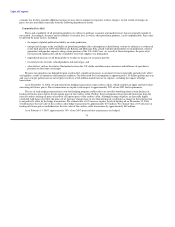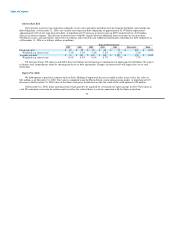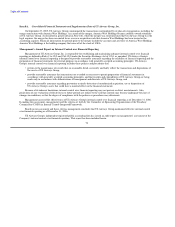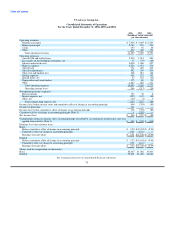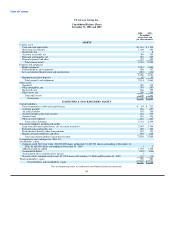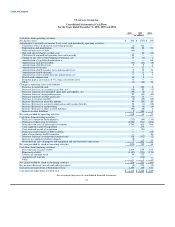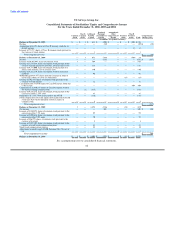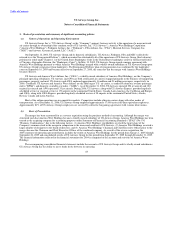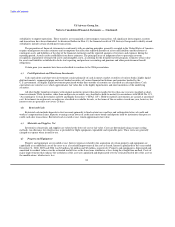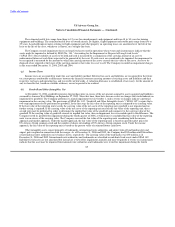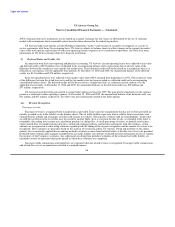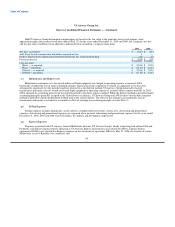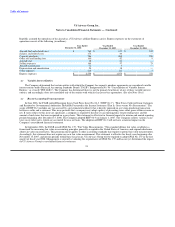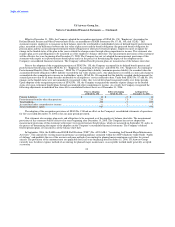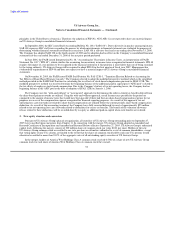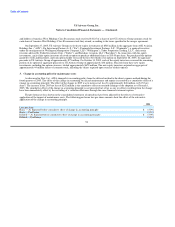US Airways 2006 Annual Report Download - page 87
Download and view the complete annual report
Please find page 87 of the 2006 US Airways annual report below. You can navigate through the pages in the report by either clicking on the pages listed below, or by using the keyword search tool below to find specific information within the annual report.
Table of Contents
US Airways Group, Inc.
Notes to Consolidated Financial Statements — (Continued)
subsidiaries to support operations. These transfers are recognized as intercompany transactions. All significant intercompany accounts
and transactions have been eliminated. As discussed further in Note 13, the financial results of US Airways Group and its wholly owned
subsidiaries include certain related party transactions.
The preparation of financial statements in conformity with accounting principles generally accepted in the United States of America
requires management to make estimates and assumptions that affect the reported amounts of assets and liabilities and disclosure of
contingent assets and liabilities at the date of the financial statements and the reported amounts of revenues and expenses during the
reporting period. Actual results could differ from those estimates. The principal areas of judgment relate to passenger revenue
recognition, impairment of long-lived assets and intangible assets, accounting for the frequent traveler program, estimates of fair value
for assets and liabilities established in fresh-start reporting and purchase accounting and pensions and other postretirement benefit
obligations.
Certain prior year amounts have been reclassified to conform to the 2006 presentation.
(c) Cash Equivalents and Short-term Investments
Cash equivalents and short-term investments consist primarily of cash in money market securities of various banks, highly liquid
debt instruments, commercial paper and asset-backed securities of various financial institutions and securities backed by the
U.S. government. All highly liquid investments purchased within three months of maturity are classified as cash equivalents. Cash
equivalents are stated at cost, which approximates fair value due to the highly liquid nature and short maturities of the underlying
securities.
All other highly liquid investments with original maturities greater than three months but less than one year are classified as short-
term investments. Debt securities, other than auction rate securities, are classified as held-to-maturity in accordance with SFAS No. 115,
"Accounting for Certain Investments in Debt and Equity Securities" ("SFAS 115"). Held-to-maturity investments are carried at amortized
cost. Investments in auction rate securities are classified as available for sale, as the terms of the securities exceed one year, however, the
interest rates are generally reset every 28 days.
(d) Restricted Cash
Restricted cash includes deposits in trust accounts primarily to fund certain taxes and fees and collateralize letters of credit and
workers' compensation claims, deposits securing certain letters of credit and surety bonds and deposits held by institutions that process
credit card sales transactions. Restricted cash is stated at cost, which approximates fair value.
(e) Materials and Supplies, Net
Inventories of materials and supplies are valued at the lower of cost or fair value. Costs are determined using average costing
methods. An allowance for obsolescence is provided for flight equipment expendable and repairable parts. These items are generally
charged to expense when issued for use.
(f) Property and Equipment
Property and equipment are recorded at cost. Interest expenses related to the acquisition of certain property and equipment are
capitalized as an additional cost of the asset or as a leasehold improvement if the asset is leased. Interest capitalized for the years ended
December 31, 2006, 2005 and 2004 was $2 million, $4 million and $2 million, respectively. Property and equipment is depreciated and
amortized to residual values over the estimated useful lives or the lease term, whichever is less, using the straight-line method. Costs of
major improvements that enhance the usefulness of the asset are capitalized and depreciated over the estimated useful life of the asset or
the modifications, whichever is less.
84


